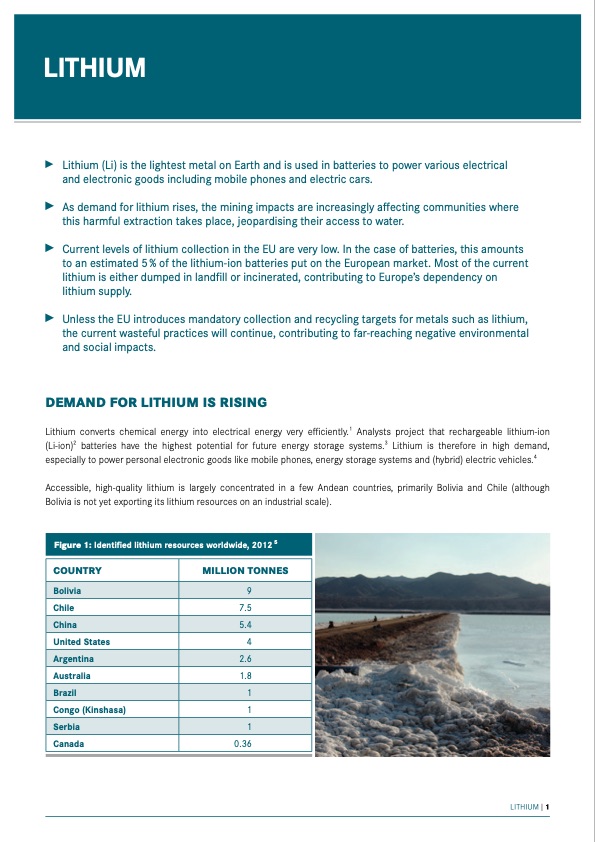
PDF Publication Title:
Text from PDF Page: 001
Lithium Lithium (Li) is the lightest metal on Earth and is used in batteries to power various electrical and electronic goods including mobile phones and electric cars. As demand for lithium rises, the mining impacts are increasingly affecting communities where this harmful extraction takes place, jeopardising their access to water. Current levels of lithium collection in the EU are very low. In the case of batteries, this amounts to an estimated 5 % of the lithium-ion batteries put on the European market. Most of the current lithium is either dumped in landfill or incinerated, contributing to Europe’s dependency on lithium supply. Unless the EU introduces mandatory collection and recycling targets for metals such as lithium, the current wasteful practices will continue, contributing to far-reaching negative environmental and social impacts. DemanD for lithium is rising Lithium converts chemical energy into electrical energy very efficiently.1 Analysts project that rechargeable lithium-ion (Li-ion)2 batteries have the highest potential for future energy storage systems.3 Lithium is therefore in high demand, especially to power personal electronic goods like mobile phones, energy storage systems and (hybrid) electric vehicles.4 Accessible, high-quality lithium is largely concentrated in a few Andean countries, primarily Bolivia and Chile (although Bolivia is not yet exporting its lithium resources on an industrial scale). figure 1: identified lithium resources worldwide, 2012 5 Country million tonnes Bolivia 9 Chile 7.5 China 5.4 united States 4 Argentina 2.6 Australia 1.8 Brazil 1 Congo (Kinshasa) 1 Serbia 1 Canada 0.36 Lithium | 1PDF Image | Lithium Li

PDF Search Title:
Lithium LiOriginal File Name Searched:
13_factsheet-lithium-gb.pdfDIY PDF Search: Google It | Yahoo | Bing
Product and Development Focus for Infinity Turbine
ORC Waste Heat Turbine and ORC System Build Plans: All turbine plans are $10,000 each. This allows you to build a system and then consider licensing for production after you have completed and tested a unit.Redox Flow Battery Technology: With the advent of the new USA tax credits for producing and selling batteries ($35/kW) we are focussing on a simple flow battery using shipping containers as the modular electrolyte storage units with tax credits up to $140,000 per system. Our main focus is on the salt battery. This battery can be used for both thermal and electrical storage applications. We call it the Cogeneration Battery or Cogen Battery. One project is converting salt (brine) based water conditioners to simultaneously produce power. In addition, there are many opportunities to extract Lithium from brine (salt lakes, groundwater, and producer water).Salt water or brine are huge sources for lithium. Most of the worlds lithium is acquired from a brine source. It's even in seawater in a low concentration. Brine is also a byproduct of huge powerplants, which can now use that as an electrolyte and a huge flow battery (which allows storage at the source).We welcome any business and equipment inquiries, as well as licensing our turbines for manufacturing.| CONTACT TEL: 608-238-6001 Email: greg@infinityturbine.com | RSS | AMP |